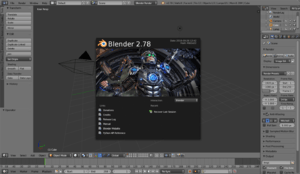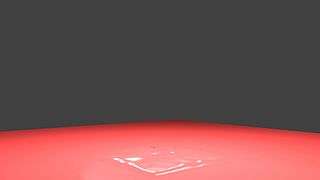Blender (software)
 | |
|
Blender 2.78 | |
| Developer(s) | Blender Foundation |
|---|---|
| Initial release | January 1995 |
| Stable release | 2.78a (October 26, 2016[1]) [±] |
| Repository |
git |
| Development status | Active |
| Written in | C, C++, and Python |
| Operating system | Windows, OS X, Linux |
| Size | 70.2 – 144.3 MiB (varies by operating system)[2] |
| Type | 3D computer graphics software |
| License | GNU General Public License v2 or later[3] |
| Website |
blender |
Blender is a professional free and open-source 3D computer graphics software product used for creating animated films, visual effects, art, 3D printed models, interactive 3D applications and video games. Blender's features include 3D modeling, UV unwrapping, texturing, raster graphics editing, rigging and skinning, fluid and smoke simulation, particle simulation, soft body simulation, sculpting, animating, match moving, camera tracking, rendering, video editing and compositing. It further features an integrated game engine.
History
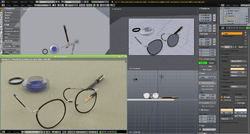
The Dutch animation studio Neo Geo developed Blender as an in-house application in January 1995,[4] with the primary author being software developer Ton Roosendaal. The name Blender was inspired by a song by Yello, from the album Baby.[5] When Neo Geo was acquired by another company, Ton Roosendaal and Frank van Beek founded Not a Number Technologies (NaN) in June 1998 to further develop Blender, initially distributing it as shareware until NaN went bankrupt in 2002.
On July 18, 2002, Roosendaal started the "Free Blender" campaign, a crowdfunding precursor.[6][7] The campaign aimed for open-sourcing Blender for a one-time payment of €100,000 (US$100,670 at the time) collected from the community.[8] On September 7, 2002, it was announced that they had collected enough funds and would release the Blender source code. Today, Blender is free, open-source software that is—apart from the Blender Institute's two full-time and two part-time employees—developed by the community.[9]
The Blender Foundation initially reserved the right to use dual licensing, so that, in addition to GPLv2, Blender would have been available also under the Blender License that did not require disclosing source code but required payments to the Blender Foundation. However, they never exercised this option and suspended it indefinitely in 2005.[10] Blender is solely available under "GNU GPLv2 or any later" and was not updated to the GPLv3, as "no evident benefits" were seen.[11]
The following program developed in each version:
| Version | Release[12] | Notes and key changes | |
|---|---|---|---|
| 2.03 | around 2002 | Handbook The official Blender 2.0 guide. | |
| 2.26 | August 20, 2003 | First ever free version. | |
| 2.30 | November 22, 2003 | New GUI; edits are now revertible. | |
| 2.32 | February 3, 2004 | Ray tracing in internal renderer; support for YafaRay. | |
| 2.34 | August 5, 2004 | LSCM-UV-Unwrapping, object-particle interaction. | |
| 2.37 | May 31, 2005 | Simulation of elastic surfaces; improved subdivision surface. | |
| 2.40 | December 22, 2005 | Greatly improved system and character animations (with a non-linear editing tool), and added fluid and hair simulator. New functionality was based on Google Summer of Code 2005.[13] | |
| 2.41 | January 25, 2006 | Improvements of the game engine (programmable vertex and pixel shaders, using Blender materials, split-screen mode, improvements to the physics engine), improved UV mapping, recording of the Python scripts for sculpture or sculpture works with the help of grid or mesh (mesh sculpting) and set-chaining models. | |
| 2.42 | July 14, 2006 | The film Elephants Dream resulted in high development as a necessity. In particular the Node-System (Material- and Compositor) has been implemented. | |
| 2.43 | February 16, 2007 | Sculpt-Modeling as a result of Google Summer of Code 2006 | |
| 2.46 | May 19, 2008 | With the production of Big Buck Bunny Blender set to produce grass quickly and efficiently.[14] | |
| 2.48 | October 14, 2008 | Due to development of Yo Frankie!, the game engine was improved substantially.[15] | |
| 2.49 | June 13, 2009 | First official stable release 2.5. New window and file manager, new interface, new Python API, and new animation system.[16] | |
| 2.57 | April 13, 2011 | First official stable release of 2.5er branch: new interface, new window manager and rewritten event — and tool — file processing system, new animation system (each setting can be animated now), and new Python API.[17] | |
| 2.58 | June 22, 2011 | New features | |
| 2.58a | July 4, 2011 | Some bug fixes, along with small extensions in GUI and Python interface.[18] | |
| 2.59 | August 13, 2011 | 3D mouse support | |
| 2.60 | October 19, 2011 | Developer branches integrated into main developer branch: among other things, B-mesh, a new rendering/shading system, NURBS, to name a few, directly from Google Summer of Code | |
| 2.61 | December 14, 2011 | Render-Engine Cycles, Motion Tracking, Dynamic Paint, Ocean Simulator | |
| 2.62 | February 16, 2012 | Motion tracking improvement, further expansion of UV tools, cycles render engine, and remesh modifier | |
| 2.63 | April 27, 2012 | Bug fixes, B-mesh project: completely new mesh system with n-corners, plus new tools: dissolve, inset, bridge, vertex slide, vertex connect, and bevel | |
| 2.64 | October 3, 2012 | Green screen keying, node based compositing | |
| 2.65 | December 10, 2012 | Over 200 bug fixes, support for the Open Shading Language, and fire simulation | |
| 2.66 | February 21, 2013 | Rigid body simulation available outside of the game engine, dynamic topology sculpting, hair rendering now supported in cycles | |
| 2.67 | May 7–30, 2013 | Freestyle rendering mode for non-photographic rendering, subsurface scattering support added, the motion tracking solver is made more accurate and faster, and an add-on for 3D printing now comes bundled | |
| 2.68 | July 18, 2013 | Rendering performance is improved for CPUs and GPUs, support for NVIDIA Tesla K20, GTX Titan and GTX 780 GPUs. Smoke rendering improved to reduce blockiness.[19] | |
| 2.69 | October 31, 2013 | Motion tracking now supports plane tracking, and hair rendering was improved | |
| 2.70 | March 19, 2014 | Initial support for volume rendering and small improvements to the user interface | |
| 2.71 | June 26, 2014 | Support for baking in cycles and volume rendering branched path tracing now renders faster | |
| 2.72 | October 4, 2014 | Volume rendering for GPUs, more features for sculpting and painting | |
| 2.73 | January 8, 2015 | New fullscreen mode, improved Pie Menus, 3D View can now display the world background.[20] | |
| 2.74 | March 31, 2015 | Cycles got several precision, noise, speed, memory improvements, new Pointiness attribute.[20] | |
| 2.75a | July 1, 2015 | Blender now supports a fully integrated Multi-View and Stereo 3D pipeline, Cycles has much awaited initial support for AMD GPUs, and a new Light Portals feature.[20] | |
| 2.76b | November 3, 2015 | Cycles volume density render, Pixar OpenSubdiv mesh subdivision library, node inserting, video editing tools[20] | |
| 2.77a | April 6, 2016 | Improvements of Cycles, new features for the Grease Pencil, more support for OpenVDB, updated Python library and support for Windows XP removed[21] | |
| 2.78a | October 26, 2016 | Spherical stereo rendering for VR, Grease Pencil improvements for 2D animations, Freehand curves drawing over surfaces, Bendy Bones, Micropolygon displacements, Adaptive Subdivision[22] | |
| Legend: Old version Older version, still supported Latest version Latest preview version Future release | |||
Suzanne
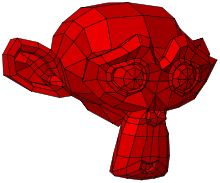
In January–February 2002 it was clear that NaN could not survive and would close the doors in March. Nevertheless, they put out one more release, 2.25. As a sort-of easter egg, a last personal tag, the artists and developers decided to add a 3D model of a chimpanzee head. It was created by Willem-Paul van Overbruggen (SLiD3), who named it Suzanne after the orangutan in the Kevin Smith film Jay and Silent Bob Strike Back.
Suzanne is Blender's alternative to more common test models such as the Utah Teapot and the Stanford Bunny. A low-polygon model with only 500 faces, Suzanne is often used as a quick and easy way to test material, animation, rigs, texture, and lighting setups and is also frequently used in joke images. Suzanne is still included in Blender. The largest Blender contest gives out an award called the Suzanne Award.
Clones
Due to Blender's open source nature, other programs have tried to take advantage of its success by repackaging and selling cosmetically-modified versions of it. Examples include IllusionMage, 3DMofun and Fluid Designer,[23] the latter recognized as Blender-based.
Features
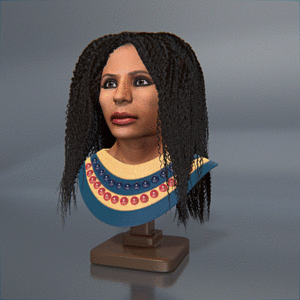
Official releases of Blender for Microsoft Windows, Mac OS X and Linux,[24] as well as a port for FreeBSD,[25] are available in both 32-bit and 64-bit versions. Though it is often distributed without extensive example scenes found in some other programs,[26] the software contains features that are characteristic of high-end 3D software. Among its capabilities are:
- Support for a variety of geometric primitives, including polygon meshes, fast subdivision surface modeling, Bezier curves, NURBS surfaces, metaballs, icospheres, multi-res digital sculpting (including dynamic topology, maps baking, remeshing, resymetrize, decimation), outline font, and a new n-gon modeling system called B-mesh.
- Internal render engine with scanline rendering, indirect lighting, and ambient occlusion that can export in a wide variety of formats.
- A pathtracer render engine called Cycles, which can take advantage of the GPU for rendering. Cycles supports the Open Shading Language since Blender 2.65.[27]
- Integration with a number of external render engines through plugins.
- Keyframed animation tools including inverse kinematics, armature (skeletal), hook, curve and lattice-based deformations, shape animations, non-linear animation, constraints, and vertex weighting.
- Simulation tools for soft body dynamics including mesh collision detection, LBM fluid dynamics, smoke simulation, Bullet rigid body dynamics, ocean generator with waves.
- A particle system that includes support for particle-based hair.
- Modifiers to apply non-destructive effects.
- Python scripting for tool creation and prototyping, game logic, importing/exporting from other formats, task automation and custom tools.
- Basic non-linear video/audio editing.
- The Blender Game Engine, a sub-project, offers interactivity features such as collision detection, dynamics engine, and programmable logic. It also allows the creation of stand-alone, real-time applications ranging from architectural visualization to video games.
- A fully integrated node-based compositor within the rendering pipeline accelerated with OpenCL.
- Procedural and node-based textures, as well as texture painting, projective painting, vertex painting, weight painting and dynamic painting.
- Real-time control during physics simulation and rendering.
- Camera and object tracking.
-
Using the node editor to create anisotropic metallic materials
-

A 3D rendering with ray tracing and ambient occlusion using Blender and YafaRay
-
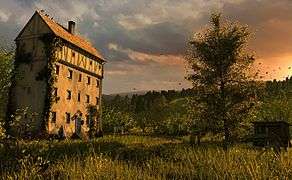
Rendering of a house
-
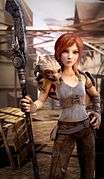
The main character from the Blender Sintel open film
-
A simple fluid simulation done with Blender
User interface
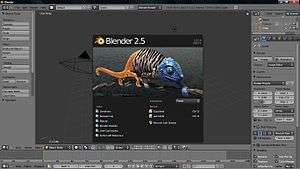
Blender's user interface incorporates the following concepts:
- Editing modes
- The two primary modes of work are Object Mode and Edit Mode, which are toggled with the Tab key. Object mode is used to manipulate individual objects as a unit, while Edit mode is used to manipulate the actual object data. For example, Object Mode can be used to move, scale, and rotate entire polygon meshes, and Edit Mode can be used to manipulate the individual vertices of a single mesh. There are also several other modes, such as Vertex Paint, Weight Paint, and Sculpt Mode.
- Hotkey usage
- Most of the commands are accessible via hotkeys. There are also comprehensive GUI menus.
- Numeric input
- Numeric buttons can be "dragged" to change their value directly without the need to aim at a particular widget, as well as being set using the keyboard. Both sliders and number buttons can be constrained to various step sizes with modifiers like the Ctrl and Shift keys. Python expressions can also be typed directly into number entry fields, allowing mathematical expressions to specify values.
- Workspace management
- The Blender GUI builds its own tiled windowing system on top of one or multiple windows provided by the underlying platform. One platform window (often sized to fill the screen) is divided into sections and subsections that can be of any type of Blender's views or window-types. The user can define multiple layouts of such Blender windows, called screens, and switch quickly between them by selecting from a menu or with keyboard shortcuts. Each window-type's own GUI elements can be controlled with the same tools that manipulate 3D view. For example, one can zoom in and out of GUI-buttons using similar controls one zooms in and out in the 3D viewport. The GUI viewport and screen layout is fully user-customizable. It is possible to set up the interface for specific tasks such as video editing or UV mapping or texturing by hiding features not used for the task.[28]
Hardware requirements
| Hardware | Minimum | Recommended | Production-standard |
|---|---|---|---|
| Processor | 32-bit dual core 2 GHz CPU with SSE2 support | 64-bit quad core CPU | 64-bit eight core CPU |
| Memory | 2 GB RAM | 8 GB RAM | 16 GB RAM |
| Graphics card | OpenGL 2.1 compatible card with 512 MB video RAM | OpenGL 3.2 compatible card with 2 GB video RAM (CUDA or OpenCL for GPU rendering) | Dual OpenGL 3.2 compatible cards with 4 GB video RAM |
| Display | 1280×768 pixels, 24-bit color | 1920×1080 pixels, 24-bit color | Dual 1920×1080 pixels, 24-bit color |
| Input | Mouse or trackpad | Three-button mouse | Three-button mouse and graphics tablet |
Supported Platforms
Blender is available for Windows Vista and above, Mac OSX 10.6 and above, and Linux. Blender 2.76b is the last supported release for Windows XP. [29]
File format
Blender features an internal file system that can pack multiple scenes into a single file (called a ".blend" file).
- All of Blender's ".blend" files are forward, backward, and cross-platform compatible with other versions of Blender, with the following exceptions:
- Loading animations stored in post-2.5 files in Blender pre-2.5. This is due to the reworked animation subsystem introduced in Blender 2.5 being inherently incompatible with older versions.
- Loading meshes stored in post 2.63. This is due to the introduction of BMesh, a more versatile mesh format.
- All scenes, objects, materials, textures, sounds, images, post-production effects for an entire animation can be stored in a single ".blend" file. Data loaded from external sources, such as images and sounds, can also be stored externally and referenced through either an absolute or relative pathname. Likewise, ".blend" files themselves can also be used as libraries of Blender assets.
- Interface configurations are retained in the ".blend" files.
A wide variety of import/export scripts that extend Blender capabilities (accessing the object data via an internal API) make it possible to inter-operate with other 3D tools.
Blender organizes data as various kinds of "data blocks", such as Objects, Meshes, Lamps, Scenes, Materials, Images and so on. An object in Blender consists of multiple data blocks – for example, what the user would describe as a polygon mesh consists of at least an Object and a Mesh data block, and usually also a Material and many more, linked together. This allows various data blocks to refer to each other. There may be, for example, multiple Objects that refer to the same Mesh, and making subsequent editing of the shared mesh result in shape changes in all Objects using this Mesh. Objects, meshes, materials, textures etc. can also be linked to from other .blend files, which is what allows the use of .blend files as reusable resource libraries.
Video editing
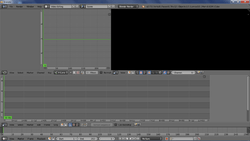
Blender features a fully functional, production ready Non-Linear video editor called Video Sequence Editor or VSE for short. Blender's VSE has many features including effects like Gaussian Blur, color grading, Fade and Wipe transitions, and other video transformations.
WebGL authoring
Blend4Web, an open source WebGL framework, can be used to convert whole Blender scenes with graphics, animation, sound and physics to work in standard web browsers. Export can be performed with a single click, even as a standalone web page.[30]
Rendering and Ray Tracing
Cycles is the path-tracing render engine that is designed to be interactive and easy to use, while still supporting many production features.[31] It comes installed as an add-on that is available by default and can be activated in the top header.
GPU rendering
Cycles supports GPU rendering which is used to help speed up rendering times. There are two GPU rendering modes: CUDA, which is the preferred method for NVIDIA graphics cards; and OpenCL, which supports rendering on AMD graphics cards. Multiple GPUs are also supported, which can be used to create a render farm – although having multiple GPUs doesn't increase the available memory because each GPU can only access its own memory.[32]
| Feature | CPU | CUDA | OpenCL |
|---|---|---|---|
| Basic Shading | Yes | Yes | Yes |
| Transparent Shadows | Yes | Yes | No |
| Motion blur | Yes | Yes | Yes |
| Hair | Yes | Yes | Yes |
| Volume | Yes | Yes | No |
| Smoke/Fire | Yes | Yes | No |
| Subsurface Scattering | Yes | Yes | No |
| Open Shading Language | Yes | No | No |
| Correlated Multi-Jittered Sampling | Yes | Yes | No |
| Branched Path integrator | Yes | Yes | No |
| Displacement/Subdivision | Experimental | Experimental | Experimental |
Integrator
The integrator is the rendering algorithm used for lighting computations. Cycles currently supports a path tracing integrator with direct light sampling. It works well for various lighting setups, but is not as suitable for caustics and some other complex lighting situations. Rays are traced from the camera into the scene, bouncing around until they find a light source such as a lamp, an object emitting light, or the world background. To find lamps and surfaces emitting light, both indirect light sampling (letting the ray follow the surface BSDF) and direct light sampling (picking a light source and tracing a ray towards it) are used.[34]
There are two types of integrators:
- The default path tracing integrator is a pure path tracer. At each hit it bounces light in one direction and picks one light to receive lighting from. This makes each individual sample faster to compute, but typically requires more samples to clean up the noise.
- The alternative is a branched path tracing integrator which at the first hit splits the path for different surface components and takes all lights into account for shading instead of just one. This makes each sample slower, but reduces noise, especially in scenes dominated by direct or one-bounce lighting.
Open Shading Language
Blender users can create their own nodes using the Open Shading Language although it is important to note that there is no support for it on GPUs.[35]
Materials
Materials define the look of meshes, NURBS curves and other geometric objects. They consist of three shaders, defining the mesh's appearance of the surface, volume inside, and displacement of the surface.[31]
Surface shader
The surface shader defines the light interaction at the surface of the mesh. One or more BSDFs can specify if incoming light is reflected back, refracted into the mesh, or absorbed.[31]
Volume shader
When the surface shader does not reflect or absorb light, it enters the volume. If no volume shader is specified, it will pass straight through to the other side of the mesh.
If one is defined, a volume shader describes the light interaction as it passes through the volume of the mesh. Light may be scattered, absorbed, or emitted at any point in the volume.[31]
Displacement shader
The shape of the surface may be altered by displacement shaders. This way, textures can be used to make the mesh surface more detailed.
Depending on the settings, the displacement may be virtual, only modifying the surface normals to give the impression of displacement (also known as bump mapping) or a combination of real and virtual displacement.[31]
Demo reels
The Blender website contains several demo reels that showcase various features of Blender.[36]
Physics
Blender can be used to simulate smoke, rain, dust, cloth, water, hair and rigid bodies.[37]
Cloth Simulation

A cloth is any piece of mesh that has been designated as 'cloth' in the physics tab.
Fluid Simulation
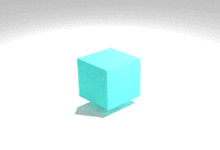
Physics Fluid Simulation
The fluid simulator can be used for simulating liquids, like water hitting a cup.[38] It uses the Lattice Boltzmann methods to simulate the fluids and allows for lots of adjusting of the amount of particles and the resolution.
Particle Fluid Simulation
The particle physics fluid simulation creates particles that follow the Smoothed-particle hydrodynamics method.[39]
Development
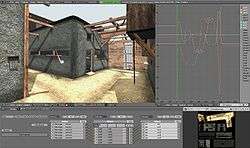
Since the opening of the source, Blender has experienced significant refactoring of the initial codebase and major additions to its feature set.
Improvements include an animation system refresh;[40] a stack-based modifier system;[41] an updated particle system[42] (which can also be used to simulate hair and fur); fluid dynamics; soft-body dynamics; GLSL shaders support[43] in the game engine; advanced UV unwrapping;[44] a fully recoded render pipeline, allowing separate render passes and "render to texture"; node-based material editing and compositing; and projection painting.[45]
Part of these developments were fostered by Google's Summer of Code program, in which the Blender Foundation has participated since 2005.
Support
Blender is extensively documented on its website,[46] with the rest of the support provided via community tutorials and discussion forums on the Internet. The Blender Network provides support and social services for Blender Professionals. Additionally, YouTube is known to have a great many video tutorials available for either Blender amateurs or professionals at no cost.
Use in the media industry
Blender started out as an inhouse tool for a Dutch commercial animation company NeoGeo.[47] Blender has been used for television commercials in several parts of the world including Australia,[48] Iceland,[49] Brazil,[50][51] Russia[52] and Sweden.[53]
Blender is used by NASA for publicly available 3D models. Many 3D models on NASAs 3D resources page are in a native .blend format.[54]
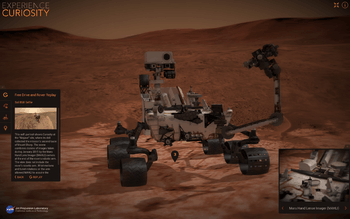
NASA also used Blender and Blend4Web to develop an interactive web application to celebrate the 3rd anniversary of the Curiosity rover landing on Mars.[55] This app[56] makes it possible to operate the rover, control its cameras and the robotic arm and reproduces some of the prominent events of the Mars Science Laboratory mission.[57][58] The application was presented at the beginning of the WebGL section on SIGGRAPH 2015.[59]
The first large professional project that used Blender was Spider-Man 2, where it was primarily used to create animatics and pre-visualizations for the storyboard department.
- As an animatic artist working in the storyboard department of Spider-Man 2, I used Blender's 3D modeling and character animation tools to enhance the storyboards, re-creating sets and props, and putting into motion action and camera moves in 3D space to help make Sam Raimi's vision as clear to other departments as possible.[60] – Anthony Zierhut,[61] Animatic Artist, Los Angeles.
The French-language film Friday or Another Day (Vendredi ou un autre jour) was the first 35 mm feature film to use Blender for all the special effects, made on Linux workstations.[62] It won a prize at the Locarno International Film Festival. The special effects were by Digital Graphics[63] of Belgium.
Blender has also been used for shows on the History Channel, alongside many other professional 3D graphics programs.[64]
Tomm Moore's The Secret of Kells, which was partly produced in Blender by the Belgian studio Digital Graphics, has been nominated for an Oscar in the category "Best Animated Feature Film".[65]
Plumíferos, a commercial animated feature film created entirely in Blender,[66] was premiered in February 2010 in Argentina. Its main characters are anthropomorphic talking animals.
Special effects for episode 6 of Red Dwarf season X were confirmed being created using Blender by half of Gecko Animation, Ben Simonds. The company responsible for the special effects, Gecko Animation, uses Blender for multiple projects, including Red Dwarf.[67] The episode screened in 2012.[68][69]
Blender was used for both CGI and compositing for the movie Hardcore Henry.[70]
Open projects
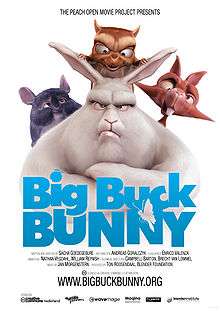

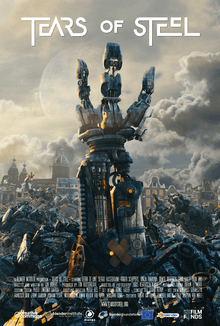
Every 1–2 years the Blender Foundation announces a new creative project to help drive innovation in Blender.
Elephants Dream (Open Movie Project: Orange)
In September 2005, some of the most notable Blender artists and developers began working on a short film using primarily free software, in an initiative known as the Orange Movie Project hosted by the Netherlands Media Art Institute (NIMk). The resulting film, Elephants Dream, premiered on March 24, 2006. In response to the success of Elephants Dream, the Blender Foundation founded the Blender Institute to do additional projects with two announced projects: Big Buck Bunny, also known as "Project Peach" (a 'furry and funny' short open animated film project) and Yo Frankie, also known as Project Apricot (an open game in collaboration with CrystalSpace that reused some of the assets created during Project Peach). This has later made its way to Nintendo 3DS's Nintendo Video between the years 2012 and 2013.
Big Buck Bunny (Open Movie Project: Peach)
On October 1, 2007, a new team started working on a second open project, "Peach", for the production of the short movie Big Buck Bunny. This time, however, the creative concept was totally different. Instead of the deep and mystical style of Elephants Dream, things are more "funny and furry" according to the official site.[71] The movie had its premiere on April 10, 2008.
Yo Frankie! (Open Game Project: Apricot)
"Apricot" is a project for production of a game based on the universe and characters of the Peach movie (Big Buck Bunny) using free software. The game is titled Yo Frankie. The project started February 1, 2008, and development was completed at the end of July 2008. A finalized product was expected at the end of August; however, the release was delayed. The game was released on December 9, 2008, under either the GNU GPL or LGPL, with all content being licensed under Creative Commons Attribution 3.0.[72]
Sintel (Open Movie Project: Durian)
The Blender Foundation's Project Durian[73] (in keeping with the tradition of fruits as code names) was this time chosen to make a fantasy action epic of about twelve minutes in length,[74] starring a teenage girl and a young dragon as the main characters. The film premiered online on September 30, 2010.[75] A game based on Sintel was officially announced on Blenderartists.org on May 12, 2010.[76][77]
Many of the new features integrated into Blender 2.5 and beyond were a direct result of Project Durian.
Tears of Steel (Open Movie Project: Mango)

On October 2, 2011, the fourth open movie project, codenamed "Mango", was announced by the Blender Foundation.[78][79] A team of artists assembled using an open call of community participation. It is the first Blender open movie to use live action as well as CG.
Filming for Mango started on May 7, 2012, and the movie was released on September 26, 2012. As with the previous films, all footage, scenes and models were made available under a free content compliant Creative Commons license.[80][81]
According to the film's press release, "The film's premise is about a group of warriors and scientists, who gather at the 'Oude Kerk' in Amsterdam to stage a crucial event from the past, in a desperate attempt to rescue the world from destructive robots."[82]
Cosmos Laundromat (Open Movie Project: Gooseberry)

On January 10, 2011, Ton Roosendaal announced that the fifth open movie project would be codenamed "Gooseberry" and that its goal would be to produce a feature-length animated film. He speculated that production would begin sometime between 2012 and 2014.[83] The film was to be written and produced by a coalition of international animation studios. The studio lineup was announced on January 28, 2014,[84] and production began soon thereafter. As of March 2014, a moodboard had been constructed[85] and development goals had been set. The initial ten minute pilot was released on YouTube on August 10, 2015.[86] It won the SIGGRAPH 2016 Computer Animation Festival Jury's Choice award.[87]
Online services
Blender Cloud
The Blender Cloud platform, launched in March 2014 and operated by the Blender Institute, is a subscription-based cloud computing platform and Blender client add-on which provides hosting and synchronization for backed-up animation project files.[88] It was launched to promote and fundraise for Project: Gooseberry, and is intended to replace the selling of DVDs by the Blender Foundation with a subscription-based model for file hosting, asset sharing and collaboration.[89][90] A feature of the Blender Cloud is Blender Sync, which provides synchronization between Blender clients for file changes, user preferences and other features.[91]
Blender ID
The Blender ID is a unified login for Blender software and service users, providing a login for Blender Cloud, the Blender Store, the Blender Conference, Blender Network, Blender Development Fund and the Blender Foundation Certified Trainer Program.[92]
See also
- Caminandes, a series of animated short films
References
- ↑ "Blender 2.78a". blender.org. October 26, 2016. Retrieved October 26, 2016.
- ↑ "Blender 2.78a". blender.org. April 6, 2016. Retrieved April 8, 2016.
- ↑ "License - blender.org". Retrieved May 17, 2014.
- ↑ "Doc:DK/2.6/Manual - BlenderWiki". Blender.org. Retrieved 2016-03-25.
- ↑ Kassenaar, Joeri (May 21, 2005). "Brief history of the Blender logo". Archived from the original on October 23, 2007. Retrieved January 18, 2007.
- ↑ Blender Foundation Launches Campaign to Open Blender Source on linuxtoday (Jul 22, 2002)
- ↑ 'Free Blender Fund' campaign archived 2002
- ↑ Membership People can subscribe to become Foundation Member. Members who subscribe during the campaign period, get additional benefits for their support. During campaign: – Costs: minimum one time fee of EUR 50 (or USD 50) (archived 2002)
- ↑ "Blender.org history". Amsterdam. June 2008.
- ↑ Roosendaal, Ton (June 2005). "Blender License". Retrieved January 19, 2007.
- ↑ Prokoudine, Alexandre (26 January 2012). "What's up with DWG adoption in free software?". libregraphicsworld.org. Retrieved 2015-12-05.
[Blender's Toni Roosendall:] "Blender is also still "GPLv2 or later". For the time being we stick to that, moving to GPL 3 has no evident benefits I know of. My advice for LibreDWG: if you make a library, choosing a widely compatible license (MIT, BSD, or LGPL) is a very positive choice."
- ↑ "Index of /source/". blender.org. Retrieved October 13, 2010.
- ↑ "Blender 2.40". blender.org. Archived from the original on March 4, 2007. Retrieved December 23, 2005.
- ↑ "3D-Software Blender 2.46 zum Download freigegeben". heise.de (in German). Retrieved May 20, 2008.
- ↑ "Blender 2.48". blender.org. Archived from the original on January 20, 2009. Retrieved December 25, 2008.
- ↑ "Blender 2.49". blender.org. Archived from the original on June 11, 2009. Retrieved June 21, 2009.
- ↑ "Blender 2.57". blender.org. Archived from the original on November 4, 2013. Retrieved April 13, 2011.
- ↑ blenderfoundation (2011-07-09). "Blender 2.58a update log". blender.org. Retrieved 2011-07-10.
- ↑ "Dev:Ref/Release Notes/2.68 - BlenderWiki". wiki.blender.org. Retrieved 2016-11-29.
- 1 2 3 4 "Past Releases". blender.org. Retrieved November 13, 2015.
- ↑ "Blender 2.77". blender.org. March 19, 2016. Retrieved March 29, 2016.
- ↑ "Blender 2.78". blender.org. September 30, 2016. Retrieved September 30, 2016.
- ↑ "Re-branding Blender". blender.org. Retrieved March 11, 2014.
- ↑ "Download – blender.org – Home of the Blender project – Free and Open 3D Creation Software". Blender Foundation. Retrieved July 30, 2014.
- ↑ "FreeBSD Ports: Graphics". The FreeBSD Project. July 27, 2014. Retrieved July 30, 2014.
- ↑ "trueSpace 7.6 specifications". Caligari Corporation. 2008. Retrieved June 6, 2011.
- ↑ "Cycles support OpenSL shading". blender.org. Retrieved January 26, 2013.
- ↑ "Using Blender with multiple monitors". Blenderguru.com. Retrieved 2012-07-06.
- 1 2 "System Requirements". blender.org. Retrieved March 29, 2016.
- ↑ "Blend4Web Official Site – About". Blend4Web.com. Retrieved 2015-06-22.
- 1 2 3 4 5 "Introduction — Blender Reference Manual". www.blender.org. Retrieved 2015-10-18.
- ↑ "GPU Rendering — Blender Reference Manual". www.blender.org. Retrieved 2015-10-18.
- ↑ "Features — Blender Reference Manual". www.blender.org. Retrieved 2016-03-24.
- ↑ "Integrator — Blender Reference Manual". www.blender.org. Retrieved 2015-10-18.
- ↑ "Open Shading Language — Blender Reference Manual". www.blender.org. Retrieved 2015-10-19.
- ↑ "Demo Reels". blender.org. Retrieved October 24, 2015.
- ↑ "Introduction to Physics Simulation — Blender Reference Manual". www.blender.org. Retrieved 2015-12-02.
- ↑ "Create a Realistic Water Simulation – Blender Guru". Blender Guru. Retrieved 2015-12-02.
- ↑ "Fluid Physics — Blender Reference Manual". www.blender.org. Retrieved 2015-12-02.
- ↑ "Blender Animation system refresh project". Wiki.blender.org. Retrieved 2012-07-06.
- ↑ "Modifiers". Wikiblender.org. Retrieved 2012-07-06.
- ↑ "New Particle options and Guides". Blender.org. Retrieved 2012-07-06.
- ↑ "GLSL Pixel and Vertex shaders". Blender.org. Retrieved 2012-07-06.
- ↑ "Subsurf UV Mapping". Blender.org. Retrieved 2012-07-06.
- ↑ "Dev:Ref/Release Notes/2.49/Projection Paint – BlenderWiki". wiki.blender.org. June 3, 2009. Retrieved October 22, 2009.
- ↑ "Main Page - BlenderWiki".
- ↑ "History". blender.org. 2002-10-13. Retrieved 2012-07-06.
- ↑ "Blender in TV Commercials". Studiorola.com. 2009-09-26. Retrieved 2012-07-06.
- ↑ "Midstraeti Showreel on the Blender Foundation's official YouTube channel". Youtube.com. 2010-11-02. Retrieved 2012-07-06.
- ↑ "New Fiat campaign in Brazil using Blender 3D". BlenderNation. Retrieved July 25, 2010.
- ↑ "Brasilian TV Commercial made with Blender". BlenderNation. Retrieved July 25, 2010.
- ↑ "Russian Soda Commercial by ARt DDs". Blendernation.com. 2010-08-25. Retrieved 2012-07-06.
- ↑ "Apoteksgruppen – ELW TV Commercial made with Blender". Vimeo.com. 2011-03-22. Retrieved 2012-07-06.
- ↑ "nasa.gov".
- ↑ "New Online Exploring Tools Bring NASA's Journey to Mars to New Generation". NASA. Retrieved 2015-08-07.
- ↑ "Experience Curiosity". NASA's Eyes. Retrieved 2015-08-07.
- ↑ "Blend4Web, NASA and the Curiosity Rover". Blend4Web Blog. Retrieved 2015-08-07.
- ↑ "Internet 3D: Take the Curiosity Rover for a Spin Right on the NASA Website". Technology.Org. Retrieved 2015-08-12.
- ↑ "Khronos Events – 2015 SIGGRAPH". Khronos. Retrieved 2015-08-13.
- ↑ "Testimonials" (Wayback Machine). Archived from the original on February 21, 2007.
- ↑ "Anthonyzierhut.com". Anthonyzierhut.com. Retrieved 2012-07-06.
- ↑ "blender". Users.skynet.be. Retrieved October 22, 2009.
- ↑ "Digitalgraphics.be". Digitalgraphics.be. Retrieved 2012-07-06.
- ↑ "Blender on the History Channel at BlenderNation". Blendernation.com. Retrieved October 22, 2009.
- ↑ "The Secret of Kells' nominated for an Oscar!". blendernation.com. 2010-02-04. Archived from the original on 2010-06-18.
- ↑ "Blender Movie Project: Plumíferos". March 8, 2006. Retrieved February 4, 2007.
- ↑ "Gecko Animation: Smegging Spaceshipes". Gecko Animation.
- ↑ "Ben Simonds Portfolio". Ben Simonds.
- ↑ "BlenderNation News article". BlenderNation.
- ↑ "Hardcore Henry – using Blender for VFX". Blender News.
- ↑ "Peach.blender.org". Peach.blender.org. 2008-10-03. Retrieved 2012-07-06.
- ↑ "Yo Frankie! – About". Apricot Open Game. Blender Foundation. Retrieved August 18, 2008.
- ↑ "Durian.blender.org". Durian.blender.org. Retrieved 2012-07-06.
- ↑ "How long is the movie?". Durian.blender.org. 2010-04-15. Retrieved 2012-07-06.
- ↑ "Sintel Official Premiere". Durian.blender.org. 2010-08-16. Retrieved 2012-07-06.
- ↑ "Sintel The Game announcement". Blenderartists.org. Retrieved 2012-07-06.
- ↑ "Sintel The Game website". Sintelgame.org. Retrieved 2012-07-06.
- ↑ "Project Mango kick-off | BlenderNation". BlenderNation. October 2, 2011. Retrieved November 28, 2011.
- ↑ Roosendaal, Ton (October 1, 2011). "Project Mango Kick-off | Mango". Blender Foundation. Retrieved November 28, 2011.
- ↑ "Tears of Steel". Blender Foundation. September 26, 2012. Retrieved September 26, 2012.
- ↑ Roosendaal, Ton (October 1, 2011). "Project Mango Kick-off | Mango". Blender Foundation. Retrieved November 28, 2011.
- ↑ Roosendaal, Ton (September 24, 2012). "Press Release" (PDF). Mango Blog. Retrieved September 26, 2012.
- ↑ "Project Gooseberry announced". Blender Nation. January 10, 2011. Retrieved 7 March 2014.
- ↑ "Gooseberry Studio lineup". January 28, 2014. Retrieved 7 March 2014.
- ↑ "Moodboard » Cosmos Laundromat - The Gooseberry Open Movie Project".
- ↑ Cosmos Laundromat - First Cycle. Official Blender Foundation release. YouTube. 10 August 2015.
- ↑ "SIGGRAPH 2016 SIGGRAPH 2016 ANNOUNCES AWARD WINNERS AND HIGHLIGHTS OF 43RD ANNUAL COMPUTER ANIMATION FESTIVAL". s2016.siggraph.org.
- ↑ Institute, Blender (30 October 2015). "Blender Cloud V3 — Blender Cloud Blog".
- ↑ "Blender Institute Announces Blender Cloud Plans". 17 January 2014.
- ↑ "Blender Cloud Relaunch". 4 June 2014.
- ↑ Institute, Blender. "Introducing Blender Sync — Blender Cloud Blog".
- ↑ "Home - Blender ID - blender.org".
Further reading
- Van Gumster, Jason (2009). Blender For Dummies. Indianapolis, Indiana: Wiley Publishing, Inc. p. 408. ISBN 978-0-470-40018-0.
- "Blender 3D Design, Spring 2008". Tufts OpenCourseWare. Tufts University. 2008. Archived from the original on July 20, 2011. Retrieved July 23, 2011.
- "Release Logs". Blender.org. Blender Foundation. Retrieved July 23, 2011.
External links
| Wikibooks has a book on the topic of: Blender 3D: Noob to Pro |
| Wikimedia Commons has media related to Blender (software). |
- Official website
- Blender Wiki
- Blender Stack Exchange (Questions & Answers)
- Blender Artists Community
- BlenderNation: Blender news site
- BlenderArt Magazine: A bi-monthly Blender magazine for Blender learners
- Blender NPR: Dedicated to Stylize and Non-Photorealistic Rendering
